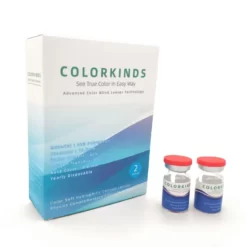Introduction
Let’s face it: being strong deutan color blind involves a lot of mystery. Unfortunately, the world has never welcomed colorblind people. To make things worse, many of us don’t know what it’s like to live with this superpower. So I’m going to let you in on a few hard-earned secrets that will hopefully clear things up for all you readers out there who are also strong deutans.
What is strong deutan color blind?
Deuteranomaly, or strong deuteranomaly, is a form of red-green color blindness that affects both men and women. It is caused by a genetic mutation of the X chromosome—the sex chromosome that determines if an individual is male or female. This mutation affects your eye’s photoreceptors (cells in the retina). It makes them see red and green differently than they should. Deuteranomaly is a “weakness” in vision. But, this doesn’t mean you’ll be unable to see clearly at all times. It means that certain colors may appear less vibrant than they would if you were not color blind.
Strong Deuteranomaly — Basic Facts
- Deuteranomaly is a form of red-green color blindness.
- It’s the most common red-green color blindness and affects about 1 in every 10,000 males.
- The disorder is inherited in an X-linked recessive manner. This means that both parents must be carriers for their child to have this condition (one copy from each parent). If one parent has deuteranomaly and the other does not, then all children will be carriers. But, none will have visual problems from this gene mutation.
Strong deutan color blindness symptoms
- People with strong deutan color blindness struggle to tell apart red and green traffic lights.
- Deuteranomaly is the most common type of color blindness and affects about 6% of the male population. This color blindness is due to a problem in the M (medium wavelength) cone. It makes it hard for people with this condition to tell red and green apart.
- They can’t see long light wavelengths linked to red, orange, or yellow. These appear dark to them. However, they can still see short wavelength colors like blue or violet.
How do i know i have deutan colour blindness
You can take a color blindness test online to see if you have deutan color blindness. The Eye Color Test is one of the most popular online tests for determining your eye color and detecting certain types of colorblindness.
If you’re still unsure if you are D-colorblind, contact a local specialist. They can give you more info or schedule an appointment. They will check if you are D-colorblind using devices and tests. These include an Ishihara Color Blindness Test.
Is there a cure for strong deutan color blindness?
There is no cure for strong deutan color blindness. But, color vision therapy can help you see colors better and improve your color vision. In this way you will be able to see the world in more accurate colors. Color vision therapy works by training the brain to recognize colors better. In some cases, patients are carefully selected. It also helps them learn to read red traffic lights at night. And tell green from red on a traffic light in the day. This therapy can correct mild red-green color blindness, such as protanopia and deuteranopia. These are caused by defects in photopigment molecules (single gene).
How common is strong deutan color blindness?
The National Eye Institute says that strong deutan color blindness is the most common type of red-green color blindness in the US. It’s also the most common form of color blindness in males. No one knows exactly how many people have it. Estimates range from 1% to 4% of all men and 0.5% to 2% of all women worldwide.
Who is affected by deuteranomaly?
Deuteranomaly is more common in males than females and is especially prevalent among younger people. This makes sense when you consider that color blindness runs in families. So, if your dad has it and you have kids with him, the odds are good that one of them will inherit it too. Deuteranomaly is also more common in people with Northern European ancestry than in other ancestries. This makes sense. The mutation causing deutan color blindness was likely among early Northern Europeans. They lived in colder times than today.
In which colors would a person with strong deuteranomaly have a problem?
Colors that strong deuteranomalous people have trouble with include red, orange, and yellow. Some with this color blindness can see green. But, it’s not usually their first choice when they’re asked to pick a color. Some with strong deuteranomaly struggle to see red, orange, and yellow. They have trouble telling them apart. Others only see problems with specific shades of red or orange. For example, the shade of an orange shirt on someone’s chest may look brown. They might also be able to tell that there is some shade of red in the image they are viewing but not be able to determine its exact hue. If a person has this type of color blindness, we say they have limited dichromacy, not full dichromacy. It just means that one-half of their cones work well, while the other half works less well.
Difference between strong deuteranomaly and strong protanomaly.
There are two types of color blindness: deuteranomaly and protanomaly. Deuteranomaly is a red-green color vision problem. Protanomaly is a blue-yellow color vision problem. So, what’s the difference between strong deuteranomaly and strong protanomaly? Both are forms of red-green color blindness (deuteranopia and protanopia). But, they differ in how well you can tell reds from greens versus blues or yellows. For example, severe deuteranopia or protanopia make it hard to tell some shades of green (e.g., grass) from some shades of yellow (e.g., ripe apples).
Strong/moderate to strong are not necessarily “color blind,”
The key point here is that people with moderate to strong red-green deficits are not necessarily “color blind.” They may have good enough color vision for most daily tasks. Even if your child has mild color vision loss, it doesn’t mean he or she will fail school tests on identifying objects by their colors! They may struggle more than others to learn color names. But, they can still do so by using alternative strategies, like matching or pointing (or both), until they learn the color’s name. Here’s another key point: Color blindness isn’t a disease; it’s inherited. Your child might be born with weak genes that hinder seeing colors. But, this doesn’t mean he’ll always feel inferior just because of his genes!
Conclusion
So I hope that this article has helped you better understand what it means to have deutan color blindness, and how you can help people who do have it. I also hope that with increased awareness of the condition and its causes, we will be able to help even more people see colors in a new way each year.
You Might Also Like The Following Articles
Red Green Colorblindness : Complete Guide 2022
9 Signs You’re a Colorblind Woman
15 Reasons Why You Should Put On Color Blind Contacts
Red-Green Colorblind Glasses You Might Interest
COVISN TPG-038 Classic Color Blind Glasses
COVISN TPG-288 Colored Contacts For Red Green Colorblind People
COVISN TPG-200 Color Blind Glasses Indoor Outdoor 2022 New Design





